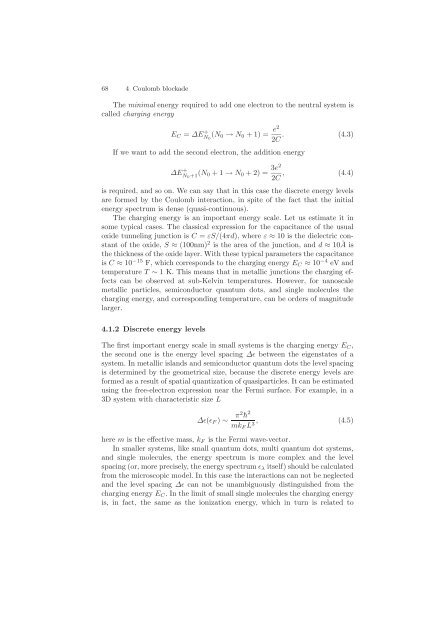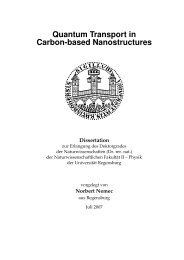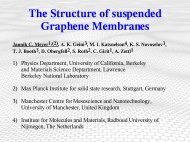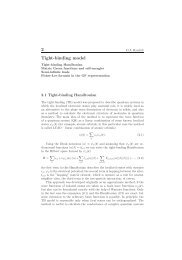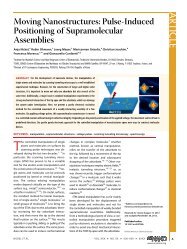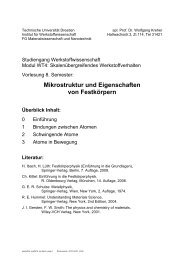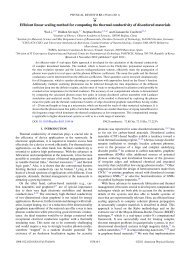4 Coulomb blockade
4 Coulomb blockade
4 Coulomb blockade
You also want an ePaper? Increase the reach of your titles
YUMPU automatically turns print PDFs into web optimized ePapers that Google loves.
68 4 <strong>Coulomb</strong> <strong>blockade</strong><br />
The minimal energy required to add one electron to the neutral system is<br />
called charging energy<br />
EC = ∆E +<br />
N0 (N0 → N0 +1)= e2<br />
. (4.3)<br />
2C<br />
If we want to add the second electron, the addition energy<br />
∆E +<br />
N0+1 (N0 +1→ N0 +2)= 3e2<br />
, (4.4)<br />
2C<br />
is required, and so on. We can say that in this case the discrete energy levels<br />
are formed by the <strong>Coulomb</strong> interaction, in spite of the fact that the initial<br />
energy spectrum is dense (quasi-continuous).<br />
The charging energy is an important energy scale. Let us estimate it in<br />
some typical cases. The classical expression for the capacitance of the usual<br />
oxide tunneling junction is C = εS/(4πd), where ε ≈ 10 is the dielectric constant<br />
of the oxide, S ≈ (100nm) 2 is the area of the junction, and d ≈ 10˚A is<br />
the thickness of the oxide layer. With these typical parameters the capacitance<br />
is C ≈ 10 −15 F, which corresponds to the charging energy EC ≈ 10 −4 eV and<br />
temperature T ∼ 1 K. This means that in metallic junctions the charging effects<br />
can be observed at sub-Kelvin temperatures. However, for nanoscale<br />
metallic particles, semiconductor quantum dots, and single molecules the<br />
charging energy, and corresponding temperature, can be orders of magnitude<br />
larger.<br />
4.1.2 Discrete energy levels<br />
The first important energy scale in small systems is the charging energy EC,<br />
the second one is the energy level spacing ∆ɛ between the eigenstates of a<br />
system. In metallic islands and semiconductor quantum dots the level spacing<br />
is determined by the geometrical size, because the discrete energy levels are<br />
formed as a result of spatial quantization of quasiparticles. It can be estimated<br />
using the free-electron expression near the Fermi surface. For example, in a<br />
3D system with characteristic size L<br />
∆ɛ(ɛF ) ∼ π2 ¯h 2<br />
, (4.5)<br />
mkF L3 here m is the effective mass, kF is the Fermi wave-vector.<br />
In smaller systems, like small quantum dots, multi quantum dot systems,<br />
and single molecules, the energy spectrum is more complex and the level<br />
spacing (or, more precisely, the energy spectrum ɛλ itself) should be calculated<br />
from the microscopic model. In this case the interactions can not be neglected<br />
and the level spacing ∆ɛ can not be unambiguously distinguished from the<br />
charging energy EC. In the limit of small single molecules the charging energy<br />
is, in fact, the same as the ionization energy, which in turn is related to


